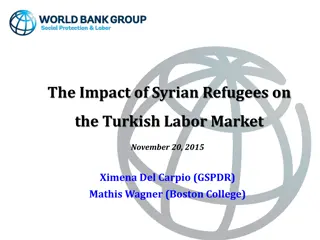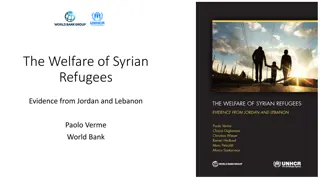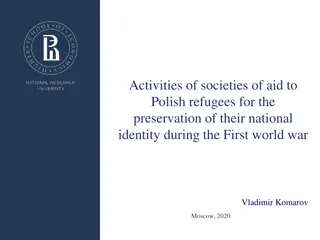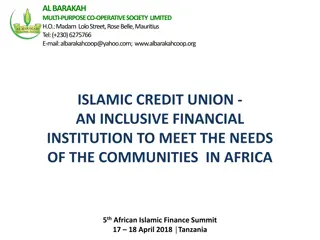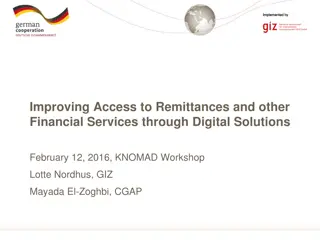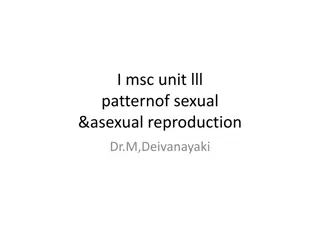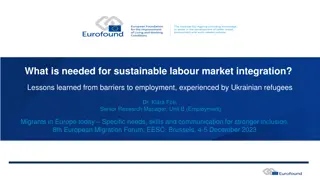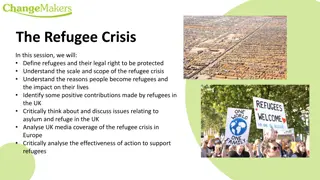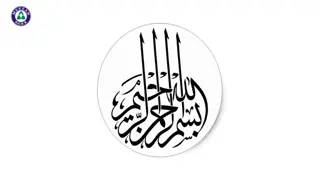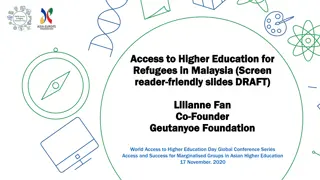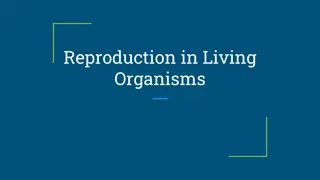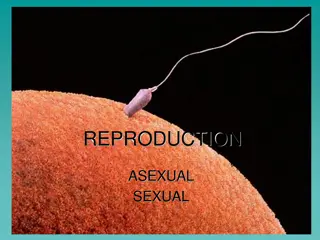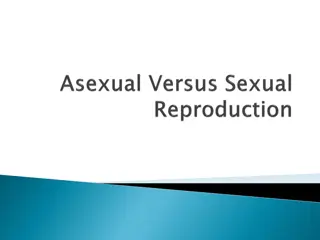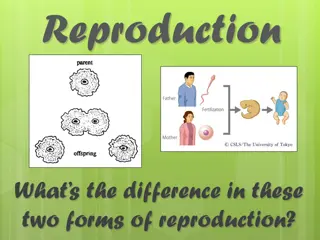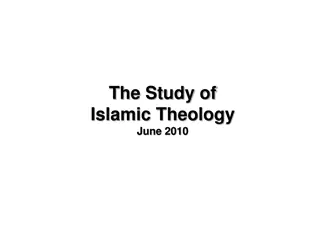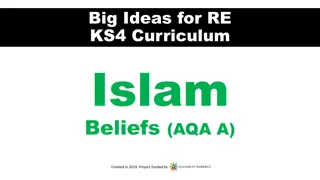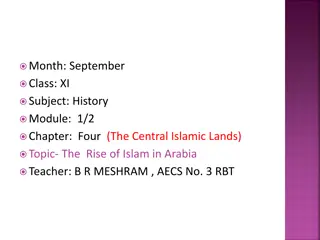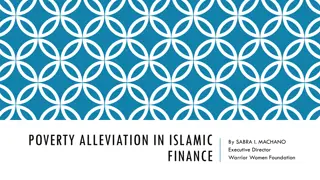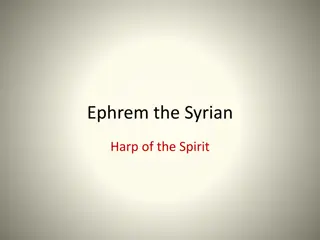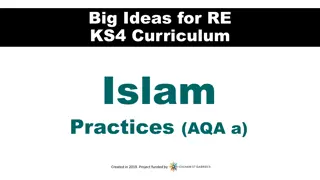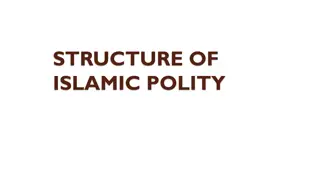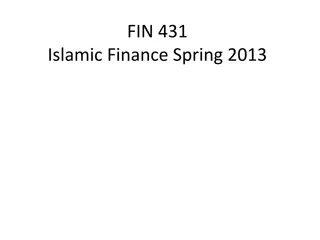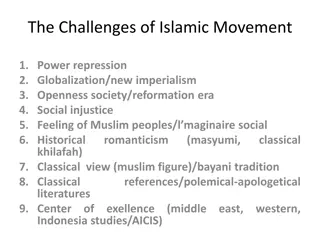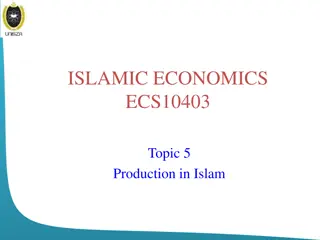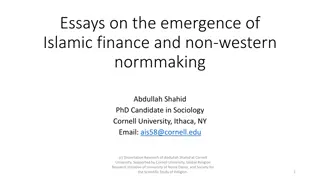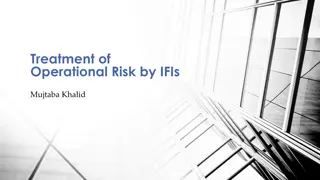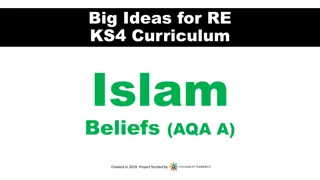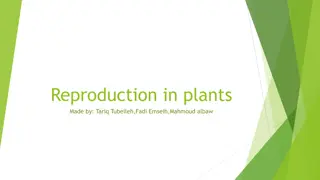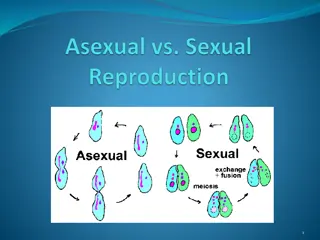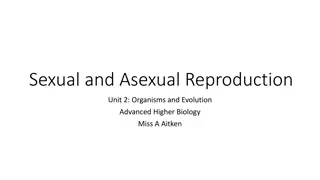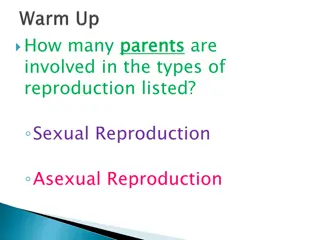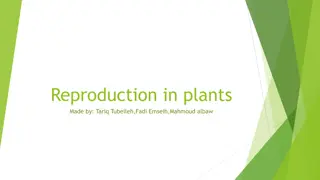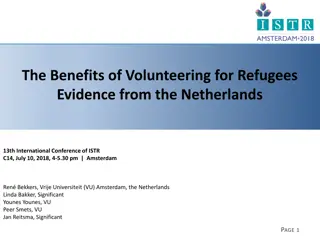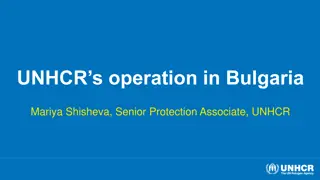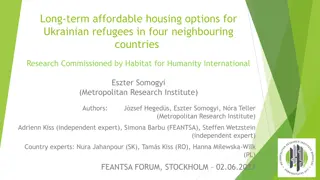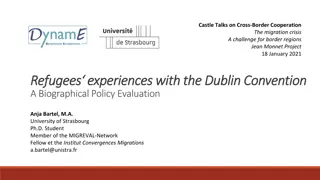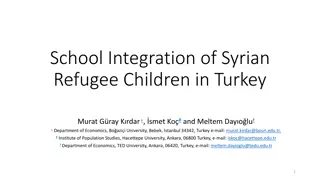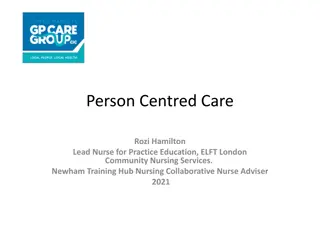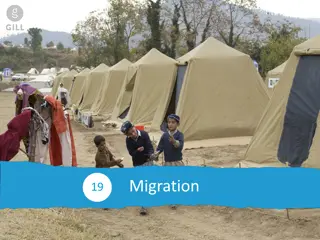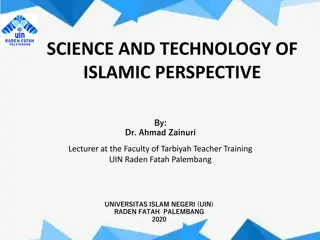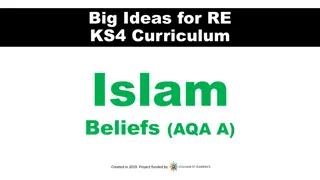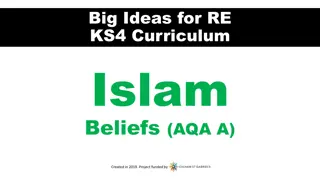Impact of Islamic Beliefs on Reproduction among Syrian Refugees
This study explores how Islamic beliefs influence experiences of reproduction among Syrian refugees in Jordan, considering the intersection of religion, gender, and culture in the context of displacement and migration. It investigates how religiously-informed notions of kinship, motherhood, and gender are shaped and transformed, and how religious orientations impact existential dilemmas related to reproduction after displacement.
Download Presentation

Please find below an Image/Link to download the presentation.
The content on the website is provided AS IS for your information and personal use only. It may not be sold, licensed, or shared on other websites without obtaining consent from the author. Download presentation by click this link. If you encounter any issues during the download, it is possible that the publisher has removed the file from their server.
E N D
Presentation Transcript
THE IMPACT OF ISLAMIC BELIEFS AND PRACTICES ON EXPERIENCES OF REPRODUCTION AMONG SYRIAN REFUGEES Morgen A. Chalmiers Master of Arts, Anthropology MD/PhD Candidate Psychological & Medical Anthropology
Study Context Over 5.5 million Syrian refugees have been externally displaced since the conflict began in 2011 This study took place in Jordan, which shares a border with Syria and hosts more than 500,000 Syrian refugees
Conceptual Background Experiences of war, displacement, and violence disrupt kinship networks: the very foundations of social and reproductive life In this context, religion becomes an essential framework through which many individuals reconcile experiences of trauma, tragedy, and profound injustice with prior beliefs about the world and the divine logic through which it is structured This project identifies reproduction as a critical juncture at which religious, gendered, and cultural ideologies intersect and are reshaped in the context of prolonged displacement
Research Questions How do religiously-informed notions of kinship, motherhood, and gender shape experience after displacement ? And how are these structures themselves transformed in the context of displacement? How do religious orientations inform attempts to grapple with the existential dilemmas that arise in relation to reproduction after displacement? How are religious & gendered subjectivities reshaped by the experience of prolonged displacement?
Caveats This project contends that individuals do not employ a singular Islamic way of addressing theodical and existential questions, but rather a multitude of practices that incorporate contextually-specific ideologies and values The study attends to the multiplicity of Islamic meaning-making practices used by Syrian refugee women, the friction between these practices and official dogma, as well as the transformation that such practices may undergo throughout the processes of migration, displacement, and resettlement
Theoretical Contributions Anthropology of Reproduction Psychological Anthropology Anthropology of Religion
Theoretical Contributions This project contributes to knowledge at the intersection of three distinct subfields within Anthropology: the anthropology of reproduction, the anthropology of religion, and psychological anthropology The following section considers how this study builds upon prior scholarship and provides a brief overview of related work in each field Anthropology of Reproduction Psychological Anthropology Anthropology of Religion
Anthropology of Reproduction Several anthropologists have considered the impact of religion on reproductive practices (Inhorn 1994, 2012; Kanaaneh 2002; Varley 2012) in Islamic contexts For example, within a biomedical setting, Inhorn (2012) has examined the diverse ways in which men make sense of their struggles with infertility, some drawing on religious discourse and others emphasizing the impact of war on their ability to father children Fewer, however, have considered religion as a direct mediator of embodied experiences of pregnancy, birth, and the postpartum period These questions overlap with central concerns in psychological anthropology and its focus on subjectivity and lived experience Medical anthropologists (e.g. Hamdy 2009, 2012) more generally have also examined how patients seek to cultivate the religious value of sabr (patience) while coping with chronic illness
Psychological Anthropology Psychological anthropology examines the most fundamental elements of human experience and has been heavily influenced by phenomenological approaches to understanding body, self, and mind across cultures (Csordas 1993) As integral tools through which individuals make sense of experience, religion and spirituality have long been central topics of inquiry for psychological anthropologists For example, Saba Mahmood s Politics of Piety (2011) has become one of the most important and influential texts in anthropology because of her careful attention to the ways in which the body becomes a vehicle through which religious subjectivities are actively cultivated among participants in the women s mosque movement in Cairo, Egypt Other notable work in this subfield (Hirschkind 2006; Scott forthcoming) has similarly considered how sensory experience and listening practices evoke particular religious subjectivities
Anthropology of Islam Anthropologists have explored the variety of ways in which individuals strive to incorporate Islamic values into their everyday lives and practices (Hamdy 2009; Deeb 2011; Mahmood 2011) This work builds upon Talal Asad s(2009) foundational analysis of Islam as a discursive tradition defined by its relation to a past upon which it makes claims to authenticity and to a future, for the sake of which knowledge of the correct, authentic form of a practice must be preserved Such scholarship on everyday Islam emphasizes that Islamic belief and practice are not monolithic, homogenous entities, but must be analyzed as historically deep, contextualized phenomena A large body of work overlapping with psychological anthropology has examined how an individual s professed beliefs (religious and otherwise) are not always congruent with her actions or speech and may, in fact, shift profoundly across different contexts (Ewing 1997)
Novel Contributions This study applies the theoretical lens and methodological tools of psychological anthropology to the field of reproduction, which has been seldom examined from this perspective In doing so, I explore the nexus at which reproductive and religious experience are embodied, building upon Varley's (2011) analysis of spirituality during childbirth to consider the entire process of pregnancy and the post-partum period The project simultaneously addresses the relatively understudied area of reproduction after displacement with a novel attention to the ways in which forced migration may trigger profound shifts in religious values, practices, and ideologies as well as the gendered norms of marriage, reproduction, and motherhood (Abusharaf 2009)
Methodological Approach Given the centrality of kinship to reproduction, my larger project incorporates ethnographic fieldwork with families divided between two distinct fieldsites: my hometown of San Diego (a refugee resettlement hub) and Jordan, a common destination for Syrian asylum-seekers I employ the anthropological methods of participant observation & ethnography as well as person-centered interviewing (Levy & Hollan 1998), a tool specific to the subfield of psychological anthropology
Person-Centered Interviews Are conducted over an extended period of time such that a single individual may participate in 5-10 interviews throughout the study period Include both informant- and respondent-style questions Informant-style questions treat participants as experts on specific local phenomenon (e.g. what are the most important religious rituals within this community? ) Respondent-style questions inquire about the interview participant s personal experiences without treating these as necessarily representative of any larger social body (e.g. tell me what your experience of fasting during Ramadan is like?)
Methods of Analysis Interviews were conducted in Arabic by the researcher and, at times, in the company of a research assistant Interviews were transcribed into Arabic script and imported into Atlas.ti qualitative analysis software (Note: Atlas.ti handles Arabic text and other right-to-left languages relatively easily and without errors, especially compared to most comparable qualitative analysis programs) Interviews were iteratively and inductively coded by the researcher with codes in both Arabic and English
Findings--A Caveat The findings of ethnographic research are best presented as narrative text rather than brief bullet-points additional discussion of the major results summarized here can be found in the author s most recent (Chalmiers 2021) and forthcoming publications in much deeper ethnographic detail This study does not aim to homogenously characterize religious practice among an extremely diverse population- the findings presented here are not intended to be representativeof Syrian or Islamic experiences of reproduction in the context of displacement Rather, these findings have been selected for their potential ability to point towards novel areas of future scholarly inquiry and illustrate the generative possibilities of research at the intersections of the three subfields previously discussed
Findings Religious Subjectivity after Displacement Echoing Hamdy s prior work (2009, 2012), experiences of hardship & suffering were conceptualized as trials that offered opportunities to strengthen one s faith and religious virtues such as patience (sabr) and gratitude (shukr or hamd) Participants did not typically cite hardships experienced during conflict or after displacement as catalysts of religious transformation; many described the natural increase in faith that comes with maturing and becoming more aware Participants also noted an increase in religious sociality specifically within the Jordanian context and expressed that more opportunities to participate in religious study groups (via WhatsApp or in-person at religious centers) were available in Jordan compared to their region of origin in Syria (most were from rural Dara a)
Findings Religiosity & Reproductive Agency Scholarship in the fields of public health, development, and humanitarianism has often emphasized the supposedly detrimental effects of religiosity on health outcomes For instance, needs assessments often describe fatalism, the belief that one s destiny is pre- determined and cannot be altered by human action, as a barrier to contraceptive use, family planning, and preventive healthcare more generally In contrast, my findings did not suggest that such analyses are oversimplified and fail to recognize that so-called Islamic attitudes towards, for example, contraception are not homogenous and vary widely across and within contexts Participants frequently emphasized the religious importance of maintaining one s health and caring for one s body which, for many, included efforts to space pregnancy for the associated health benefits Participants who encountered hardships in their reproductive lives (miscarriages, infertility, etc.) described religion as a source of strength and some were inspired by these hardships to actively improve their religious devotion and practices
Findings Religion is not always the Relevant Framework Scholarship across disciplines has at times overemphasized the salience and role of religion in everyday life, especially in relation to gendered health outcomes Especially in settings of displacement or other precarious contexts, it s important to understand how everyday practices (reproductive or otherwise) are frequently more influenced by conditions of material scarcity and uncertainty than religious beliefs (see Chalmiers 2021)
About the Researcher: Morgen A. Chalmiers is an MD/PhD Candidate in the Psychological & Medical Anthropology at UC San Diego School of Medicine. She was recently recognized as an Emerging Scholar in Family Planning for her research on barriers to reproductive healthcare for resettled refugee women in San Diego. Her anthropological research broadly examines women s experiences of reproductive healthcare using the tools and theoretical lens of psychological anthropology. She works with a collaborative team across the UC campuses to conduct community-engaged, multi-sited research on resettled refugee women s access to reproductive healthcare. Her dissertation project explores reproductive decision-making and access to care among Syrian refugees in Jordan. Her fieldwork and clinical practice are informed by the paradigm of reproductive justice and a commitment to addressing health disparities through an intersectional framework. She is passionate about integrating anthropological insights into clinical practice and health policy through interdisciplinary collaboration.
About the Researcher: Visit www.morgenchalmiers.com for the latest updates on my work and please email morgen.chlamiers@gmail.com with any questions or comments!
References Chalmiers, Morgen A. (2021). Life Is Tight Here : Displacement and Desire amongst Syrian Refugee Women in Jordan. Anthropology of the Middle East, 16(1), 49- 69. Csordas, T. J. (1993). Somatic modes of attention. Cultural anthropology, 8(2), 135-156. Deeb, L. (2011). An enchanted modern: Gender and public piety in Shi'i Lebanon. Princeton University Press. Ewing, K. P. (1997). Arguing sainthood: modernity, psychoanalysis, and Islam. Duke University Press. Hamdy, Sherine. (2012). Our Bodies Belong to God: Organ Transplants, Islam, and the Struggle for Human Dignity in Egypt. Univ of California Press. Hamdy, Sherine F. (2009). Islam, Fatalism, and Medical Intervention: Lessons from Egypt on the Cultivation of Forbearance (Sabr) and Reliance on God (Tawakkul). Anthropological Quarterly: 173 196. Hirschkind, C. (2006). The ethical soundscape: Cassette sermons and Islamic counterpublics. Columbia University Press. Inhorn, Marcia C. (1994). Quest for Conception: Gender, Infertility and Egyptian Medical Traditions. University of Pennsylvania Press. Inhorn, Marcia C. (2012). The New Arab Man: Emergent Masculinities, Technologies, and Islam in the Middle East. Princeton University Press. Kanaaneh, Rhoda Ann. (2002). Birthing the Nation: Strategies of Palestinian Women in Israel, vol.2. Univ of California Press. Levy, Robert I., and Douglas W. Hollan. (1998).Person-Centered Interviewing and Observation. Handbook of Methods in Cultural Anthropology: 333 364. Mahmood, Saba. (2011). Politics of Piety: The Islamic Revival and the Feminist Subject. Princeton University Press. Scott, Melissa J. Nice but not necessary: Humanitarian Norms, Music Education, and Cultural Diplomacy in Amman, Jordan. Forthcoming. Varley, Emma. (2011). Fieldnotes Excerpt: Faith and Loss in a Northern Pakistani Labor Room. Practical Matters(4): 1 13. Varley,Emma (2012) Islamic Logics, ReproductiveRationalities:Family Planning in Northern Pakistan Anthropology & Medicine19(2): 189 206


